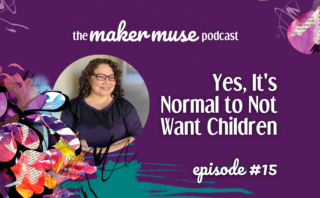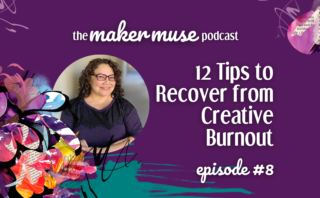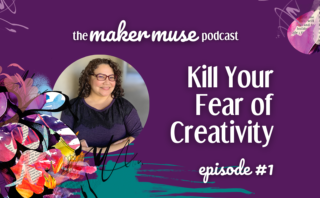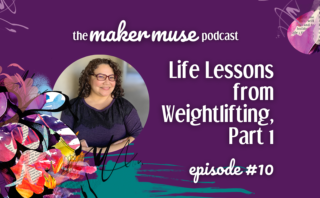Let’s put to rest the idea that you can only be creative OR analytical. Humans have one big brain and they use both sides, whether they realize it or not. You’re making artistic decisions every day, even if you don’t think of yourself as especially creative. Here’s how to recognize them and realize your own abilities as a maker, creative, and artist.
After listening to this episode, you’ll become more aware of the art that is all around you and be able to give yourself permission to be and ACT creatively.
Scroll down for the full episode transcript.
This post may contain affiliate links. For more information, please see my Disclosure Policy.*
In this episode:
- 4:37 – Vitruvian Man
- 4:39 – Mona Lisa
- 4:55 – Da Vinci Bridge
Socialize online
Subscribe to the mailing list and follow The Maker Muse on:
Transcript:
0:02
Hola, and welcome to The Maker Muse Podcast. I’m Paulette Erato, The Maker Muse. Today I’m asking the question: are you an artist or a scientist? Actually, let me ask a few more. Who is more creative: a scientist or an artist? Am I an artist or a scientist? Can you be an artist and a scientist? Are you more of an artist or a scientist?
0:05
Well, all of those questions are based on a false premise. Because yes, you can be and probably are both. So let’s get into it.
0:36
You hear the words art, maker, and creativity thrown around a lot. But what do they really mean? Let’s start off with some dictionary definitions so we’re all on the same page, okay?
0:49
A maker is a person or thing that makes or produces something. Creativity is the use of the imagination or original ideas, especially in the production of an artistic work. And finally, an artist is a person skilled at a particular task, or occupation.
1:08
Do you see how vague all of those definitions are going off of that a maker simply produces something, an artist is merely a person skilled at a thing. And creativity is just using your imagination.
1:21
And yet, a lot of people are afraid to call themselves any of these, either a maker, an artist, or even a creative. But I’m getting ahead of myself, we’ll touch back on that a little later.
1:33
Makers, creatives, and artists come in all different flavors. And even in the same genre two artists can make wildly different styles of art. Take two chefs, even if they’re using the exact same recipe, their individual dishes are going to come out quite differently. They’re going to enhance them differently, they’re probably even going to plate them differently. So in the end, the experience for their customers is not going to be the same from one to the next. And yet those dishes were based on the exact same thing, right?
2:03
You’ve probably experienced this, think of your favorite food. And I’m going to tell you now I use a lot of food related metaphors, because food is my love language. Let’s make it simple and let’s just say hamburgers. You can have a hamburger from McDonald’s for a couple of bucks. Or you can get a gourmet burger at a steakhouse. You already know you’re going to have a completely different burger from one to the other, right? Yet they both start off as a burger. It’s a piece of meat between two pieces of bread. But the experience of the $2 Burger versus the I don’t know $20 burger is not the same.
2:35
Another example (and I like this one so you may have heard me talk about it before). Think of those paint and sip nights, you know, when you go to a bar and everyone tries to paint the same plant or vase or whatever. Everybody does the exact same thing. And yet none of those paintings ever come out looking identical, do they? I mean, they’re similar, but they’re not the same.
2:55
Now, let’s look around your own home for art. Because one point I really want to drive home for you is that art is not solely what hangs in museums. It’s not locked away for only a small portion of society or an elite social class to enjoy. Art is everywhere.
3:12
Sure, it can be what you choose to display on your walls or your shelves. But it’s also what comes through the radio or your streaming service, the architectural elements of those walls, the food in your fridge, any books or journals you own. Even the flowers you grow in your garden or candles you choose to burn, people made all those things. The clothing you’re wearing right now, were made by someone. Gardeners, singers, architects, bakers, writers, actors, book makers, even floral designers, seamstresses, and candle makers. They’re all artists, because all of that is art.
3:47
Humans are creative. We’re all makers. But some people don’t quite believe that yet. Why? Well, maybe they’ve bought into the whole left brain versus right brain myth. They think you are either creative or analytical. And I’m here to tell you, that’s a lie. You are not one or the other. You are both, you have one whole big brain.
4:10
So back to the original point. Art doesn’t only live in museums, it’s everywhere. And art is not separate from science. You can be both artistic and analytical. You do not have to choose one or the other.
4:26
Case in point you probably know about one of the most famous guys who was both a scientist and an artistic genius, which made him a polymath. That’s a new word. He’s the one who created the Vitruvian Man. Or maybe you’ve heard of the Mona Lisa? If not check the show notes for links to both because the person we’re talking about is Leonardo da Vinci. He was really good in science and painting. And a lot of his scientific discoveries were still employing today. Check out the show notes for a link to the Da Vinci Bridge, which he proposed over 500 years ago. And yet most pop culture references to him or only about his paintings.
5:04
Another example I want to give you is a quote from Max Planck, he was a scientist who discovered quantum physics, which is the study of atoms. When he was talking about innovative and pioneering scientists like himself, he said “that a vivid intuitive imagination is required, because new ideas aren’t created by deduction. But by artistically creative imagination.”
5:27
Think about it like this. The math that got humans to the moon didn’t even exist yet when they first started imagining making a moon landing a reality. Someone had to create a new way of thinking about flying in order to make it happen. Now, I don’t expect you to be da Vinci or Max Planck. I’m just giving your brain proof because we don’t like to believe things without solid evidence, that the two can coexist. And I want you to realize that both aspects can live within you too. Because in the case of flying to the moon, both are necessary, just like Max Planck said.
6:04
So what do you do when you spent your whole life thinking you’re left-brained and not creative? Well, take a look at your hobbies. First, do you have any? And if not, then why not? I’m going to get into the importance of hobbies in a future episode, but first and foremost, look at how you spend your free time. And remember that art is all around you. And after listening this far into the episode, you’re beginning to see that too. It’s in the lines of your car, or in the design of your coffee mug. There’s a camera in your phone, which means every time you take a picture, you’re a photographer. Every time you make a meal, you’re the chef. Every time you choose to wear the green underwear, or the red glasses, or the purple shoes, or you choose one frame for your pictures over another, you’re making creative choices. Lean into that. And then start looking around for what else in your life, you can fill with creativity.
6:57
You don’t even have to be good at it. Making art, making creative choices, being a maker isn’t about being good or bad at the thing. It’s just about doing the thing over and over. Remember our dictionary definitions at the top of the episode? They didn’t make a lot of qualifications about being good at something. Here, let me read them to you again.
7:15
A maker is a person or thing that makes or produces something. It doesn’t say whether or not they do that well, just that they do it. Creativity is the use of the imagination or original ideas, especially in the production of an artistic work. It doesn’t say that their ideas are good or bad, just that they’re applied to making stuff. An artist is a person skilled at a particular task. Okay, that one’s a bit qualified. But what does skilled even mean? Skilled: that’s a learned behavior, something you get by doing. It doesn’t matter if it’s good or bad. Can you be an artist while you’re picking up these skills? Yes! You can start off as a bad artist with poor skills. Remember, from the last episode, you get to be bad when you first start, how else will you get good?
8:06
It’s like swimming. You don’t learn how to swim by standing at the side of the pool or watching videos on YouTube. Sure, you can learn the mechanics of swimming and the science of why we float in water. But to actually know what it’s like to hold your breath underwater? You got to jump in and do that, then you develop better skills around it.
8:25
Actually, here’s a better example riding a bike. That’s a skill. And there’s a common saying that relates riding a bike to remembering how to do something that we think we forgotten. Because riding a bike is about muscle memory, right? Most everyone who has ever learned to ride a bike won’t forget how to do it. They might wobble a bit the first time back on a bicycle. But other than that it comes back pretty quickly, right? Okay, great. But how did most of us learn to ride that bike in the first place? What helped keep us balanced when we first started out?
9:00
Training wheels, we used training wheels. Why did we need training wheels? Because we didn’t yet have the skills to balance on top of two wheels. How long you use training wheels for doesn’t matter. Eventually they came off. When you acquired enough skill to balance on your own, you could finally remove the training Going out every day or whenever you could to ride that bike. Pedaling, pedaling, pedaling all over the place, or maybe just your front sidewalk. But you kept doing that until one day you didn’t need them anymore.
9:40
I have a vague but distinct memory of the day I took off my training wheels. We lived on a hill with a steep driveway too. So learning to bike up those inclines was an ordeal on its own. Going downhill is easy, right? Uphill, not so much. So anyway, my dad has me on my bike, no training wheels he’s holding onto the back of a bike so I can get situated. Then he’s running alongside me as I’m pedaling, and suddenly he lets go. Did I know he let go? Probably not. But there was riding a bike! I had acquired the skills to ride a bike without training wheels. And developing art skills happens in much the same way.
10:20
Remember, last episode, I told you how my brother used to tease me that I sounded like a dying cow when I tried singing? I’m still working on getting that voice out of my head. But anyway, if I wanted to become a better singer, I could learn that right? I could hire a singing coach who would teach me the ins and outs of singing. I might never become an opera diva, or a pop star. But I could probably get good enough to sing on key. Or maybe I could put in the work to become a pop princess, who knows.
10:48
The point is that it only takes working on that skill. Just like learning to ride a bike, you keep at it. You start off not so good at things or just plain bad at them. And then you get better. Yay!
11:02
So here’s what I want you to take away from this episode. One is that art is all around you. It doesn’t just live in museums. And it’s not just for a specific class of people that are different from you and me. Art is everywhere.
11:17
Number two is you can be both artistic and analytical. You do not have to constrain yourself to just one side of your brain. You’re allowed—and I encourage you, I give you permission—to use both sides. No matter what you’ve been told or believed about yourself up to this point, you have two sides of your brain, and you can use them both.
11:38
Finally, number three: don’t be afraid to think and act creatively. Whether it’s buying the green underwear or learning to sing, the opportunities to be a maker, an artist, a creative are all around you.
11:55
And if you’re interested in getting out of your own way and onto a creative path, grab a free copy of my easy to follow Destination: Innovation Roadmap. It’s a quick five step overview for getting to your own creative core. The link is in the show notes.
12:11
And that’s a burrito. Thanks for listening to The Maker Muse Podcast. I’d love if we could make this a regular thing for you and me, so please subscribe to the podcast and tell all of your family and friends about it. And I’d really appreciate it if you can rate and review it wherever you’re listening to this right now. Nos vemos!




